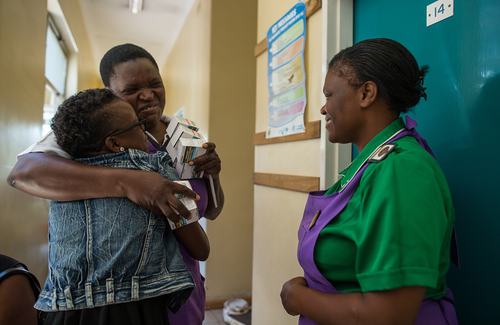
"We, as Africans, are the agenda and have the capacity to lead the HIV response. We need to create our own funding bill. Africans and its leaders have a role to play in conceptualising ideas and solutions," Yvette Raphael from the Advocates for the Prevention of HIV in Africa told the recent INTEREST conference in Maputo, Mozambique.
Raphael urged governments and scientists to reduce their reliance on donor funding for HIV initiatives to achieve ownership and sustainable programmes.
International funding remains the highest contributor to the HIV/AIDS response in Africa. This threatens the sustainability of HIV programmes, particularly with increasing pressures on international budgets. This is already being witnessed with decreased donor funding for Malaria, HIV/AIDS and TB in recent years. To sustain the current progress, domestic financing and leadership are critical.
Researchers from APIN Public Health Initiatives in Nigeria conducted a study comparing the funding sources for HIV between South Africa and Nigeria, which have the two largest economies in Africa. While Nigeria has an HIV prevalence of 1.4% among adults and an estimated 1.9 million people living with HIV, South Africa has 18% prevalence with over 7 million people with HIV.
They analysed financial and programme performance data from UNAIDS and other sources to categorise funding contributions for HIV programming into domestic and international sources. Between 2017 and 2020, the domestic funding contribution to HIV in South Africa (69-77%) was about four to six times higher than in Nigeria (12-17%). Over 80% of HIV funding in Nigeria was from international sources, compared to less than 30% in South Africa. However, international funding has started to decline in Nigeria.
The researchers suggest Nigeria's seemingly higher achievements on HIV key performance indicators compared to South Africa could be threatened by the country's over-dependence on dwindling donor funds. According to UNAIDS 2021 data, in Nigeria, 90% of people living with HIV know their status, 98% are on treatment, and 95% have a suppressed viral load, while for South Africa, the numbers are 94-79-91.
The significant contribution of domestic funding to the total HIV expenditure in South Africa demonstrates a high level of local ownership that better positions South Africa for sustainability.
However, some African countries are already taking charge. A poster presentation from researchers at Makerere University School Of Public Health, Kampala, outlined the country's experience of transitioning from international donors and its implications.
Between November 2021 and January 2022, the investigators explored innovative approaches that subnational health systems managers adopted to ensure sustainable financing of HIV/AIDS services amidst donor transition in Uganda. The qualitative study was conducted in three districts representing three regions of the country that received support from donors in the global north. Interviews were conducted with 25 district health managers and providers.
Health managers leveraged government funding for primary care, maternal and child health, sanitation and environmental health, and immunisation services to ensure the continuity of HIV/AIDS services. Staff who previously worked for donor-funded programmes were brought into the public sector workforce. Other strategies included increasing patients’ out-of-pocket payments and sharing linkage facilitators between different community partners and health programmes, so as to maintain community outreach activities
In Tanzania, researchers from the National Institute For Medical Research, Dar Es Salaam, investigated the costs associated with providing malaria, HIV/AIDS and TB services. They collected quantitative and qualitative data in eight regions throughout the mainland of the country, with rural and urban districts included. A micro-costing approach was used to collect cost data from a provider perspective for one year in 88 public health facilities.
The total financial gap was estimated to be US$ 1.5 billion for HIV, US$ 400 million for malaria and US$ 86 million for TB. The projected financial resources needed to support these services for ten years was estimated to be US$ 8.5 billion.
To expand domestic resources, the researchers suggested the establishment of compulsory Universal Health Insurance, increasing out-of-pocket payments, and imposing taxation on social services, food products, drinks and mobile phone bundles.
In Namibia, investigators conducted a study to assess the constraints to the financial sustainability of the HIV response in the country. This aimed to establish pathways and actions to transition from development assistance to domestic financing.
Transition challenges included the lack of social health insurance schemes, a weak framework for procuring HIV commodities, an unsupportive public financial management system, and low use of primary health centres. Limited public support and the absence of a national AIDS council also made it difficult to mobilise resources for community-led interventions.
These studies show that governments are now thinking about and establishing alternative financing mechanisms to support HIV programmes. However, more African countries still need to reinforce policies and strategies to increase domestic funding of their HIV programmes.
Babatunde D et al. Readiness for Sustainability –A Comparative Study of Nigeria and South Africa's HIV Financing Landscape. INTEREST, Maputo, abstract 295, 2023.
Ssegujja E et al. Sustainable Financing for HIV/AIDS Services Following Donor Transition and Its Implications for Continuity of Care. Experiences From a Subnational Level in Uganda. INTEREST, Maputo, abstract 443, 2023
Ngadaya F et al. Health System Costs and Feasibility of Alternative Mechanisms for Expanding Domestic Resources Mobilization to Finance Malaria, HIV/AIDS and TB Services in Tanzania. INTEREST, Maputo, abstract 122, 2023.
Ogbuabor D et al. Sustainable Financing of the HIV Response in Namibia:Lessons From an End-Term Review of a National HIV Response. INTEREST, Maputo, abstract 17, 2023.


